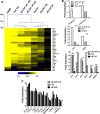Vpu-deficient HIV strains stimulate innate immune signaling responses in target cells
- PMID: 22647704
- PMCID: PMC3421769
- DOI: 10.1128/JVI.00424-12
Vpu-deficient HIV strains stimulate innate immune signaling responses in target cells
Abstract
Acute virus infection induces a cell-intrinsic innate immune response comprising our first line of immunity to limit virus replication and spread, but viruses have developed strategies to overcome these defenses. HIV-1 is a major public health problem; however, the virus-host interactions that regulate innate immune defenses against HIV-1 are not fully defined. We have recently identified the viral protein Vpu to be a key determinant responsible for HIV-1 targeting and degradation of interferon regulatory factor 3 (IRF3), a central transcription factor driving host cell innate immunity. IRF3 plays a major role in pathogen recognition receptor (PRR) signaling of innate immunity to drive the expression of type I interferon (IFN) and interferon-stimulated genes (ISGs), including a variety of HIV restriction factors, that serve to limit viral replication directly and/or program adaptive immunity. Here we interrogate the cellular responses to target cell infection with Vpu-deficient HIV-1 strains. Remarkably, in the absence of Vpu, HIV-1 triggers a potent intracellular innate immune response that suppresses infection. Thus, HIV-1 can be recognized by PRRs within the host cell to trigger an innate immune response, and this response is unmasked only in the absence of Vpu. Vpu modulation of IRF3 therefore prevents virus induction of specific innate defense programs that could otherwise limit infection. These observations show that HIV-1 can indeed be recognized as a pathogen in infected cells and provide a novel and effective platform for defining the native innate immune programs of target cells of HIV-1 infection.
Figures




References
-
- Akira S, Uematsu S, Takeuchi O. 2006. Pathogen recognition and innate immunity. Cell 124:783–801 - PubMed
-
- Benjamini Y, Hochberg Y. 1995. Controlling the false discovery rate: a practical and powerful approach to multiple testing. J. R. Stat. Soc. B Methodol. 57:289–300
-
- Blazejczk M, Miron M, Nadon R. 2007. Presented at the Genome, Montreal, Quebec, Canada
-
- Bosinger SE, et al. 2004. Gene expression profiling of host response in models of acute HIV infection. J. Immunol. 173:6858–6863 - PubMed
Publication types
MeSH terms
Substances
Grants and funding
LinkOut - more resources
Full Text Sources

